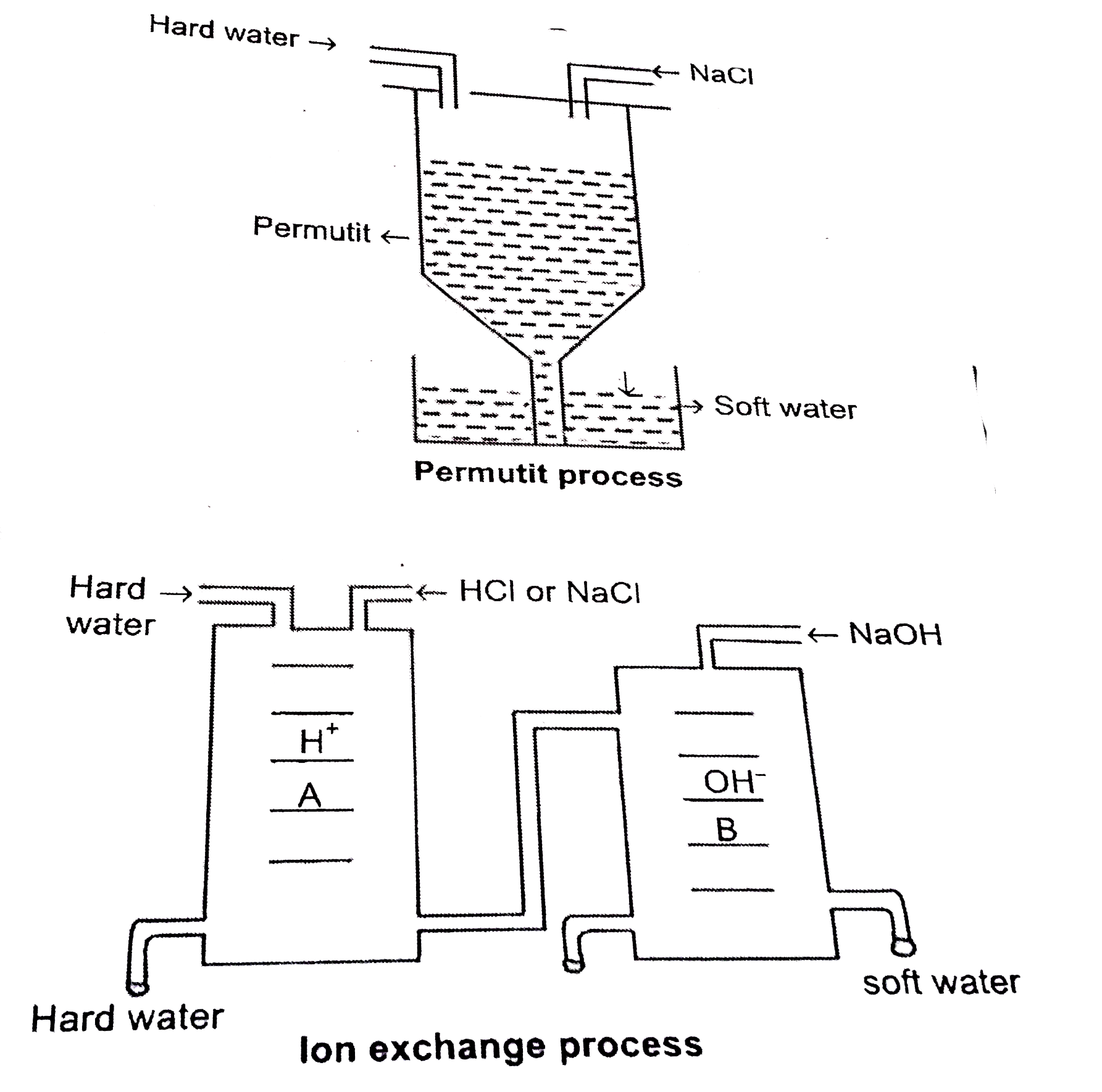What are the disadvantages of hard water? Explain the various methods of removal of permanent hardness of water with diagrams.
Text Solution
Disadvantages of hardness
Due to the presence of various dissolved salts in water, hard water is not suitable for use for various purposes.
(i) Not suitable for drinking.
(ii) Due to very poor lather formation, it is not effective for washing, cleaning and bathing purposes. ltbr> (iii) Scale formation in boilers results in loss of heat and wastage of fuels in industries.
(iv) Not effective for dyeing of fabrics due to improper fixing of dye to the fabric.
Removal of temporary hardness
(a) Boiling: However, when the water is subjected to boiling, these bicarbonates get converted to insoluble carbonates and can be removed by filtration. Since the hardness is removed by simple boiling, it is called temporary hardness and the water is called temporary hard water.
Ca(HCO3)2Δ−−→CaCO3+H2O+CO2
Mg(HCO3)2Δ−−→MgCO3+H2O+CO2
Clark's method: This method involves the addition of slaked lime to water either in solid or in liquid form. This also results in conversion of soluble bicarbonates to insoluble carbonates. On filtration, soft water is obtained.
Ca(HCO3)2+Ca(OH)2→2CaCO3⏐↓+2H2O
Mg(HCO3)2+Ca(OH)2→CaCO3⏐↓+MgCO3⏐↓+2H2O
If water dissolves other minerals in it, such as chlorides and sulphates, they also cause hardness of water. However, these salts can not be removed by boiling. Hence, the hardness imparted by these salts is called permanent hardness.
Removal of permanent hardness
There are various methods adopted to remove permanent hardness.
(a) Addition of washing soda (sodium carbonate): this method can remove both temporary as well as permanent hardness from water. Bicarbonate salts as well as sulphate and chloride salts undergo double decomposition reaction with sodium carbonate. In these reactions, the insoluble carbonates formed get precipitated and are removed by filtration.
Ca(HCO3)2+Na2CO3→CaCO3⏐↓+2NaHCO3
MgSO4+Na2CO3→MgCO3↓+Na2SO4
CaCl2+Na2CO3→CaCO3↓+2NaCl
Permutit process: Hydrated sodium aluminum silicate is called permutit. (Na2Al2Si2O8.xH2O). The sample of hard water is allowed to pass through a cylindrical tube filled with permutit. As the water passes through permutit, the calcium and magnesium ions of hard water are replaced by sodium ions. Sodium ions do not cause any precipitation with soap and do not hinder the formation of lather. Thus the water is said to be softened. After some time, the entire permutit contains Ca+2 and Mg+2 in place of Na+ ions. This is called exhausted permutit. This can be regenerated by sending sodium chloride solution through exhausted permutit.
(c ) Ion exchange method: As the name indicates, this method involves exchange of hardness causing ions by other ions. In this method, the apparatus consists of two cylindrical tubes A and B known as cation exchanger and anion exchanger respectively.
These ion exchangers contain porous solids which do not dissolve in water but swell in water. These solids are called ion exchange resins. They contain mobile groups or ions which can be exchanged with other ions. The resin containing groups or ions capable of exchanging cations is called cation exchange resin and the resin containing groups or ions capable of exchanging anions is called anion exchange resin. H-cation exchanger results in exchange of Ca+2 or Mg+2 ions by H+ ions. Na-cation exchanger results in exchange of Ca+2 or Mg+2 ions by Na+ ions. Hard water is first passed through tube 'A' where all the positive ions are displaced by H+ or Na+ ions depending on the type of resin used. The water is then passed through tube 'B' where all the negative ions are displaced by OH− ions present in anion exchange resin. Thus the water coming out of ion exchange apparatus now contains only pure water. This is also called demineralised water. When the cation exchanger and anion exchanger get depleted of H+ and OH− ions, the ion exchange resins are regenerated by passing HCl solution and sodium carbonate solution through the tubes A and B respectively.
MgCl2+2H+Resin→Mg−Resin+2HCl
RNH3OH+Cl−→RNH3Cl+OH−
H++OH−→H2O

|
Updated on:21/07/2023
Related Playlists
- BOOK - PEARSON IIT JEE FOUNDATIONCHAPTER - WaterEXERCISE - Level-140videos
Water
- BOOK - PEARSON IIT JEE FOUNDATIONCHAPTER - WaterEXERCISE - Level 233videos
Water
- BOOK - PEARSON IIT JEE FOUNDATIONCHAPTER - WaterEXERCISE - Short-Answer Type Questions20videos
Water
- BOOK - PEARSON IIT JEE FOUNDATIONCHAPTER - MOCK TESTEXERCISE - EXERCISE25videos
MOCK TEST
Similar Questions
State the disadvantages of using hard water.
View SolutionExplain one method of removing permanent hardness.
View SolutionGive an equation for the removal of permanent hardness in water.
View SolutionThe method used to remove temporary hardness of water is
View SolutionThe method used to remove temporary hardness of water is
View SolutionExplain the role of lime and washing soda for the removal of permanent hardness of water.
View SolutionThe method used to remove temporary hardness of water is:
View SolutionThe method used to remove temporary hardness of water is:
View SolutionThe method used to remove temporary hardness of water is:
View SolutionThe method used to remove temporary hardness of water is:
View Solution

